Study area: Spain, Cantabrian Mountains (Las Ubiñas-La Mesa and Babia-Luna Natural Parks)
Beginning of ringing and monitoring activities: 2017
Ringing and field work activity: Starting in 2017
Main goals of the activities:
• Melanin-based colour responses to climate change. A case study with snowfinches (genus Montifringilla and Pyrgilauda). Project funded by the British Ecological Society (2016). The aim of this project is to study whether and to what extent melanin-based colouration patterns of snowfinches (species and subspecies of the genus Montrifringilla and Pyrgilauda) are associated with eco-evolutionary responses to global warming.
• Abiotic and Biotic Influences on Spatio-temporal Population Dynamics in Alpine Environmental Conditions: the snowfinches as a case study. Project funded by MINECO – Spanish Ministry of Economy and Competitiveness (2017-2020).
We aim at collecting a database that will form a spatio-temporal time-series that will bring information on causal pathways, making it possible to address the following objectives:
a-Disentangling the roles of abiotic and biotic factors influencing population size and distribution throughout monitoring the reproductive and wintering populations;
b-Disentangling the roles of abiotic and biotic factors influencing spatio-temporal synchrony in population dynamics;
c-Disentangling the roles of abiotic and biotic factors influencing the evolution of communal roosting;
d-Disentangling the roles of abiotic and biotic factors influencing dispersal and group movement dynamics through both colour ringing and radio-marking methods;
Ringing activity results: not yet
Colour ring project: to be defined
Monitoring of reproductive biology: yes
Coordinator of the Spanish in the Central Cantabrian Mountains Group "Las Ubiñas-La Mesa and Babia-Luna Natural Parks"
• Maria del Mar Delgado - Biodiversity Research Institute (UMIB, UO-CSIC-PA), Oviedo
• Rafael Benjumea - Biodiversity Research Institute (UMIB, UO-CSIC-PA), Oviedo
Researchers involved (Central Cantabrian Mountains)
Publication
• María del Mar Delgado, Raphaël Arlettaz, Chiara Bettega, Mattia Brambilla, Miguel de Gabriel Hernando, Antonio España, Ángel Fernández-González, Ángel Fernández-Martín, Juan Antonio Gil, Sergio Hernández-Gómez, Paola Laiolo, Jaime Resano-Mayor, José Ramón Obeso, Paolo Pedrini, Isabel Roa-Álvarez, Christian Schano, Davide Scridel, Eliseo Strinella, Ignasi Toranzo and Fränzi Korner-Nievergelt (2021) Spatio-temporal variation in the wintering associations of an alpine bird: The Royal Society. Collection. Proc. R. B 288:20210690 - doi.org:101098/rspb.2021.0690
• PhD thesis Chiara Bettegadel (2021) Migration strategies and circannual patterns of habitat use of snowfinches (Montifringilla nivalis nivalis) in a patchy alpine landscape.
• Mattia Brambilla, Jaime Resano-Mayor, Raphael Arlettaz, Chiara Bettega, Anais Binggeli, Giuseppe Bogliani, Veronika Braunisch, Claudio Celada, Dan Chamberlain, Jules Chiffard Carricaburu, Maria Del Mar Delgado, Philippe Fontanilles, Primoz Kmecl, Franzi Korner, Robert Lindner, Paolo Pedrini, Jakob Pohacker, Borut Rubinič, Christian Schano, Davide Scridel, Eliseo Strinella, Norbert Teufelbauer, and Miguel De Gabriel Hernando. Potential distribution of a climate sensitive species, the White-winged Snowfinch Montifringilla nivalis in Europe. Bird Conservation International (2020) 30:522–532. © BirdLife International
• Jaime Resano-Mayor, Chiara Bettega, María del Mar Delgado, Angel Fernandez-Martín, Sergio Hernandez-Gomez, Ignasi Toranzo, Antonio Espana, Miguel de Gabriel, Isabel Roa-Alvarez, Juan Antonio Gil, Eliseo Strinella, Keith A. Hobson, Raphael Arlettaz (2020) Partial migration of White-winged snowfinches is correlated with winter weather conditions: Global Ecology and Conservation 24 (2020) e01346.
• Chiara Bettega, Angel Fernandez-Gonzalez, Jose Ramon Obeso & Maria Del Mar Delgado (2020) Circannual variation in habitat use of the: IBIS (2020) doi: 10.1111/ibi.12829.
• Del gado M.M., Bettega C., Martens J. & Päckert M. (2019) Ecotypic changes of alpine birds to climate change. Scientific Reports, 9:16082.
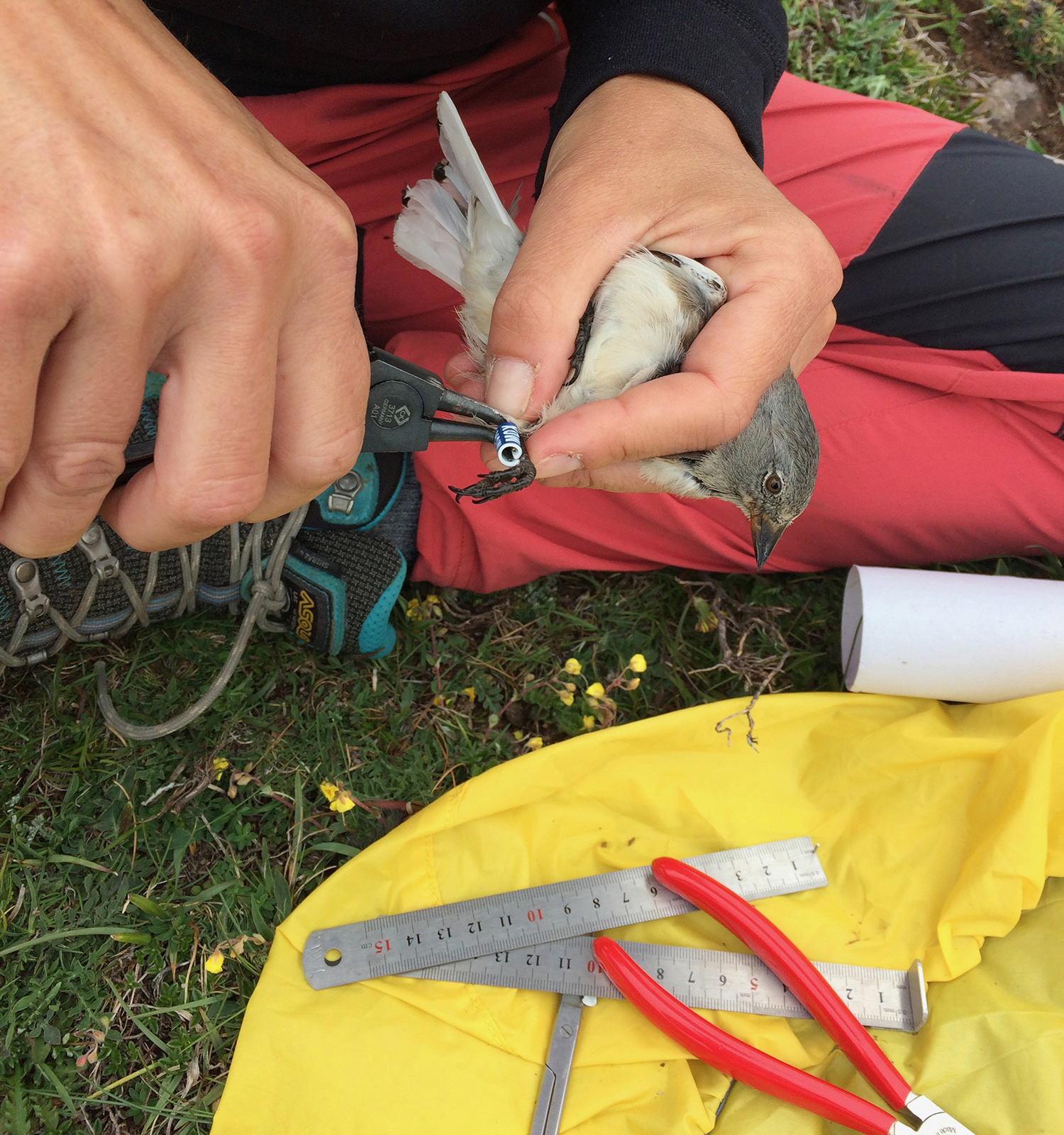
© author Chiara Bettega
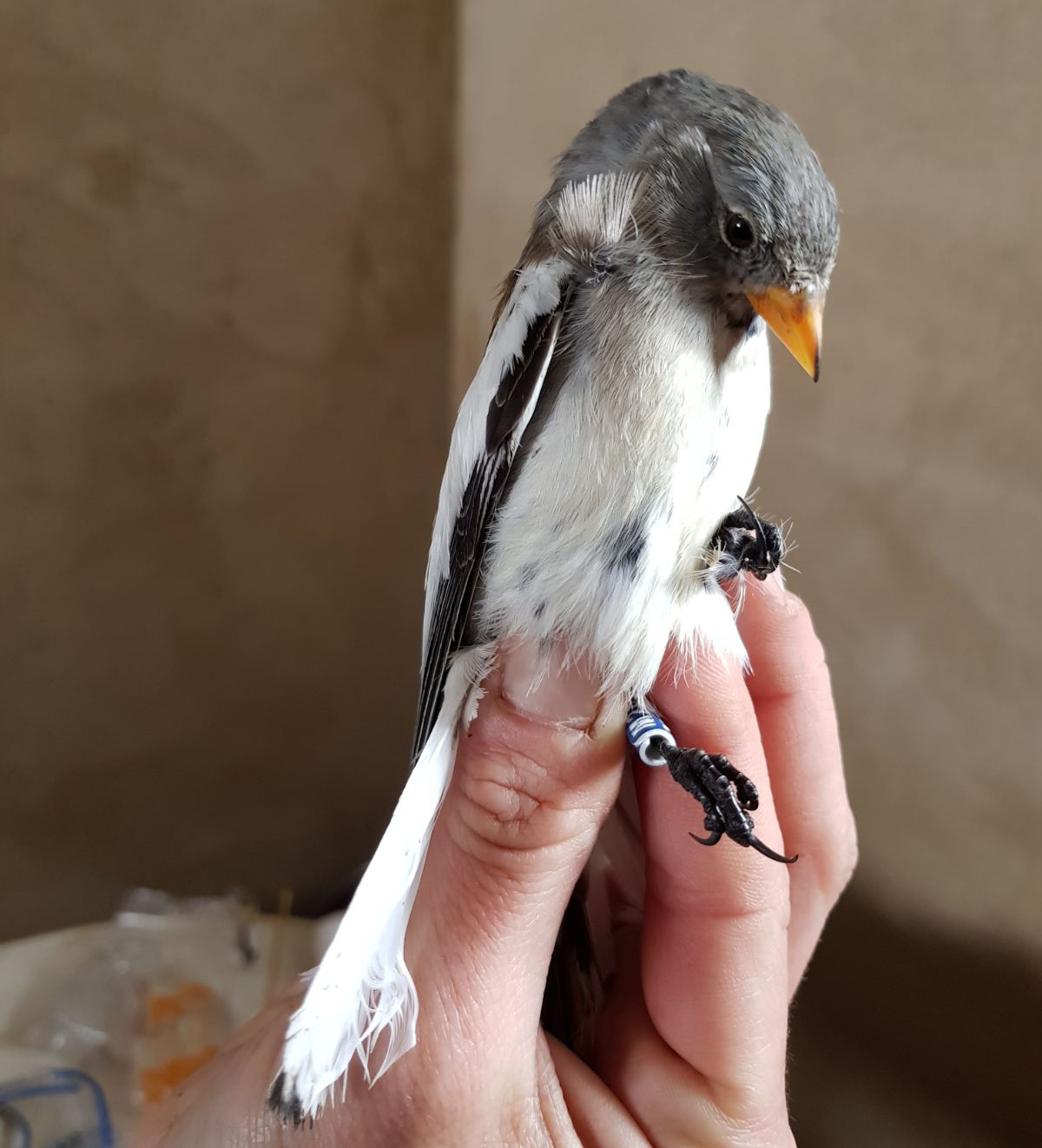
© author Chiara Bettega
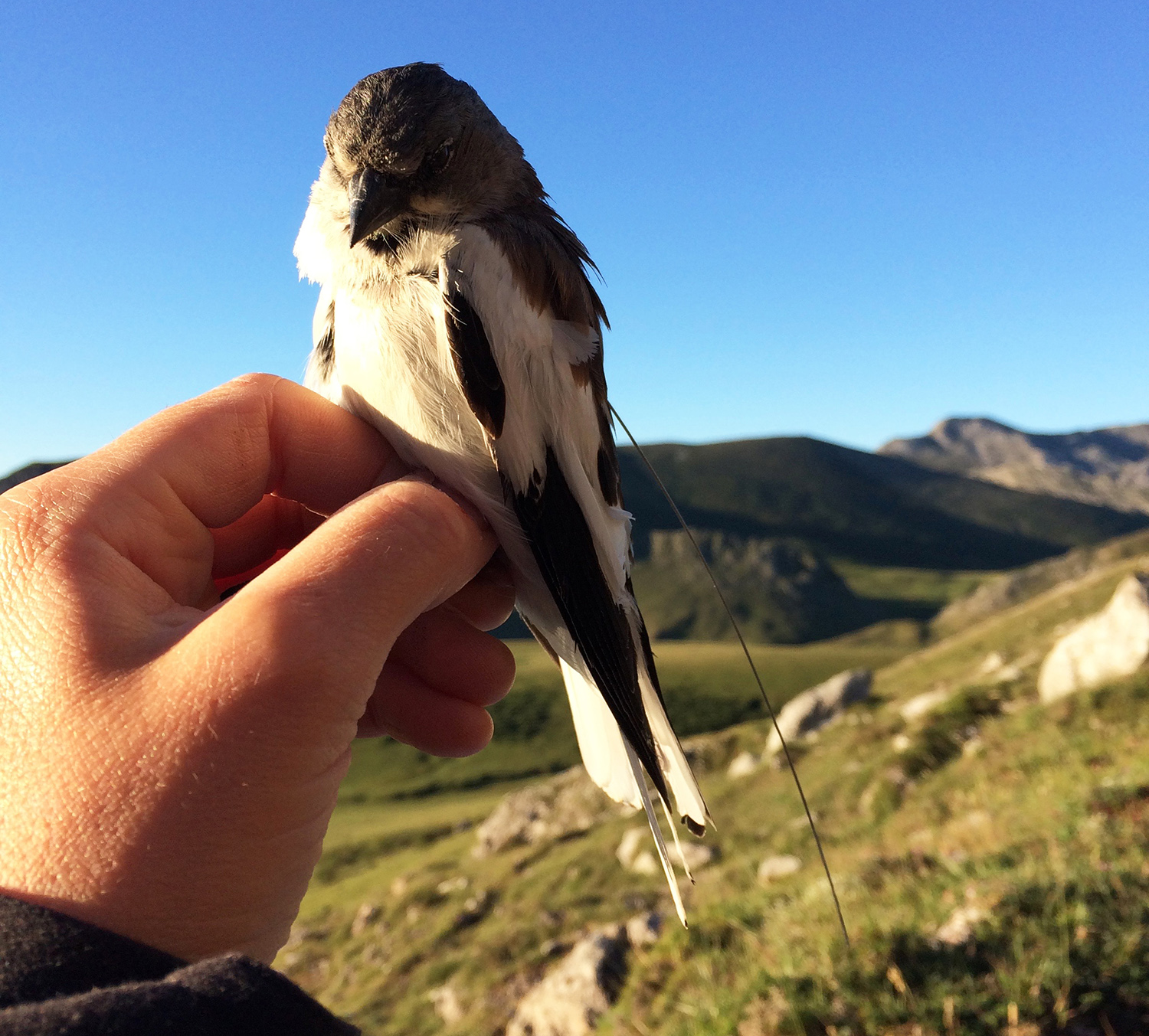
© author Maria del Mar Delgado
"The first snowfinch - a male - with a GPS"
Central Cantabrian Mountains Group "Las Ubiñas-La Mesa and Babia-Luna Natural Parks"
After three years of hard work, finally we could recapture the first snowfinch – a male - with a GPS and get the data of its movements during an entire year. Snowfinches are known to undertake nomadic movements during the winter and we know about individuals breeding in the Alps that move to the Pyrenees during winter. Nevertheless, information are still scarce, the patterns of movement that the species exhibit are still poorly investigated (due to the difficulties of working on high mountain environments) and might be more heterogeneous than what we think.
This individual, for example, spent the whole year in our study area and never flew away. He moved among three massifs, covering a maximum linear distance of 13 km and undertaking altitudinal movements from the end of the breeding season (August) to the end of the winter (March); these movements are linked to the amount of snow that covers mountain tops, so that after heavy snofwalls, snowfinches are forced to move downslope to find food.
We have 14 more snowfinches with GPS to recapture and find out where they have been moving. We also keep tagging new birds this year, to increase the chances of getting movement data back.
Route: © author Maria del Mar Delgado & Chiara Bettega
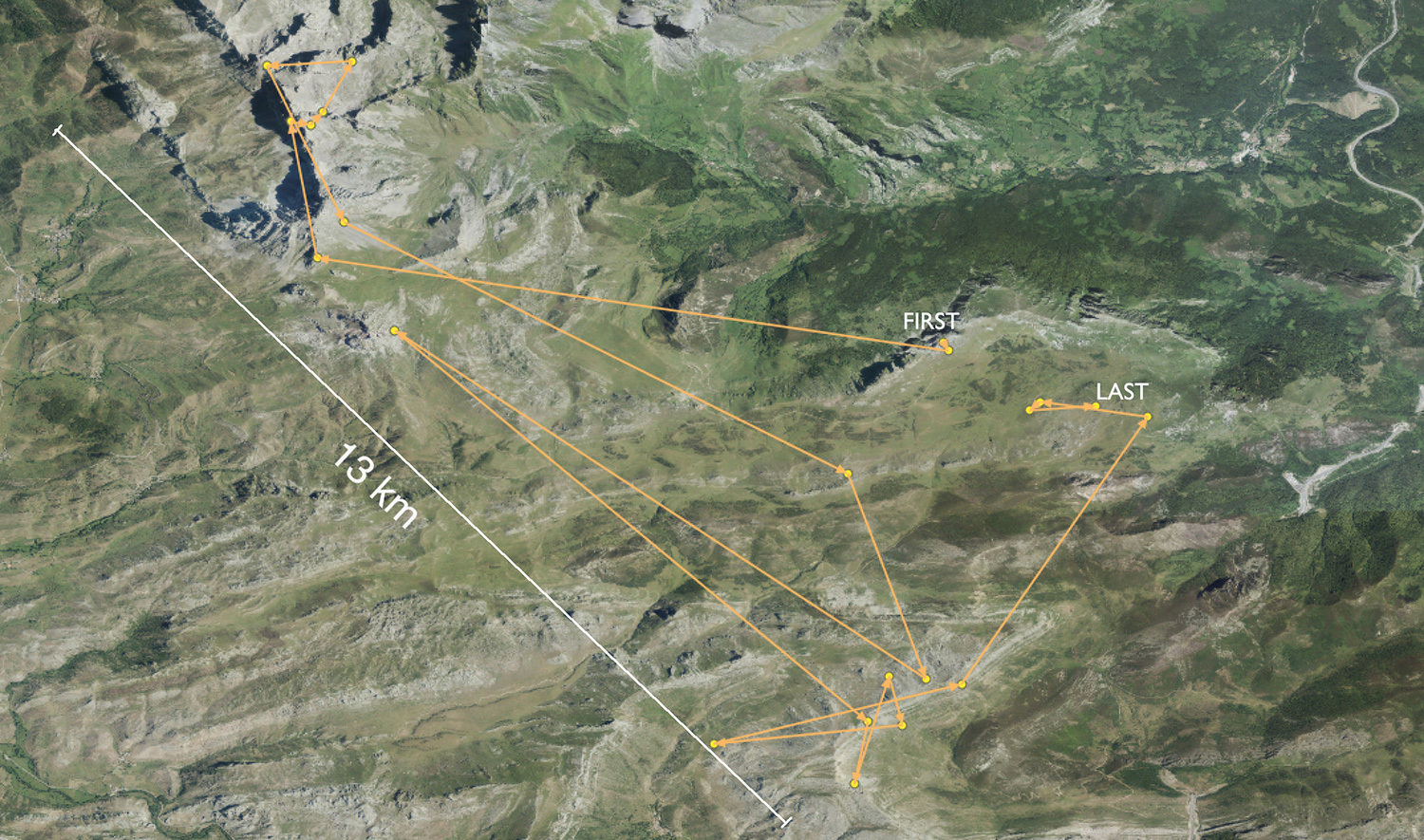
Spain Cantabrian Mountains - Las Ubiñas-La Mesa Natural Park
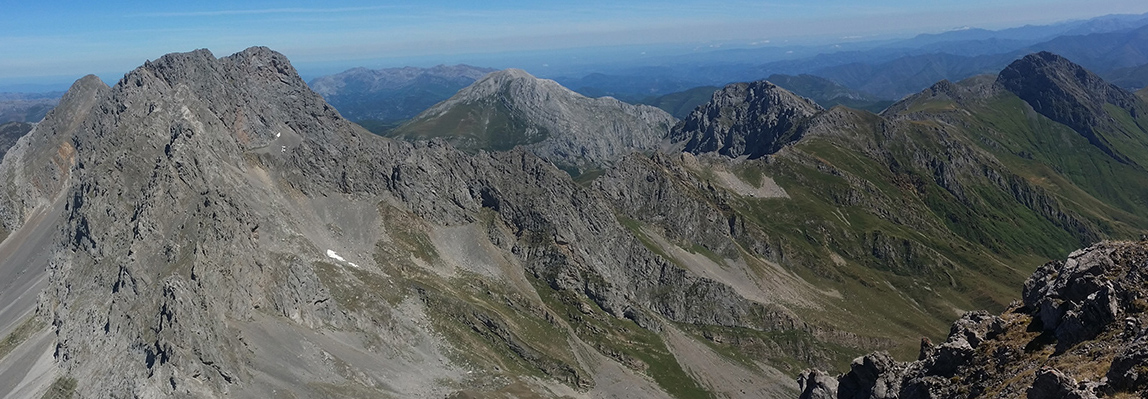
© author Maria del Mar Delgado

© author Chiara Bettega
